by Jennifer Bearden | Jun 8, 2022
Watercraft and Fishing: Stop Aquatic Hitchhikers: Keep your Kayak and Other Paddle Craft Clean!
In the 3rd installment of our PlayCleanGo program, Scott Jackson will show you how to keep paddle craft clean of invasive species that may be present in the water. Inspecting, rinsing, cleaning, and drying your equipment are important steps to reduce the transmission of invasive species which can wreak havoc on our wildlife and native plants.
[youtube https://www.youtube.com/watch?v=YxWFtrGlojU&w=560&h=315]
by Jennifer Bearden | Jun 7, 2022
Hair, Hay, and Hooves: The Places Where Invasive Plants May be Lurking
In the 2nd installment of our PlayCleanGo program, Jennifer Bearden showcases how horse owners can ensure that their equestrian activities don’t introduce invasive plants. Within the video, Jennifer identifies cleaning / inspection techniques for horses, trucks, and feed along with other ways to be proactive in preserving our environment such as using the Ivegot1 app
[youtube https://www.youtube.com/watch?v=ow1A9G28MG8&w=560&h=315]
by Jennifer Bearden | Jun 6, 2022
Hiking: Watch Your Step and Clean Your Soles
The first of 5, this video created by Rick O’Connor and Carrie Stevenson discusses how residents can enjoy the outdoors and wildlife trails while still making sure to preserve the environment. Brushing and cleaning your shoes, bags, and clothing helps remove the seeds of invasive plants. By taking a few simple steps, you can help support our beautiful native plants and wildlife so that yourself and others can continue to enjoy it.
[youtube https://www.youtube.com/watch?v=kDEk7Xp1M8Y&w=560&h=315]
by Jennifer Bearden | Jun 6, 2022
PlayCleanGo is an educational campaign by the North American Invasive Species Management Association. The goal is to stop the spread of invasive species as we recreate in our beautiful environment. Each day we will feature a new video highlighting different recreational activities.
[youtube https://www.youtube.com/watch?v=qCAvPa9VjhY]
Day 1: Hiking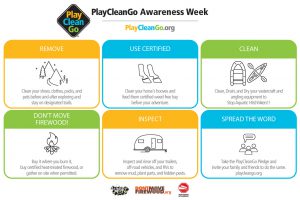
Day 2: Horseback Riding
Day 3: Watercraft and fishing
Day 4: Camping and firewood
Day 5: ATVs and Trailers
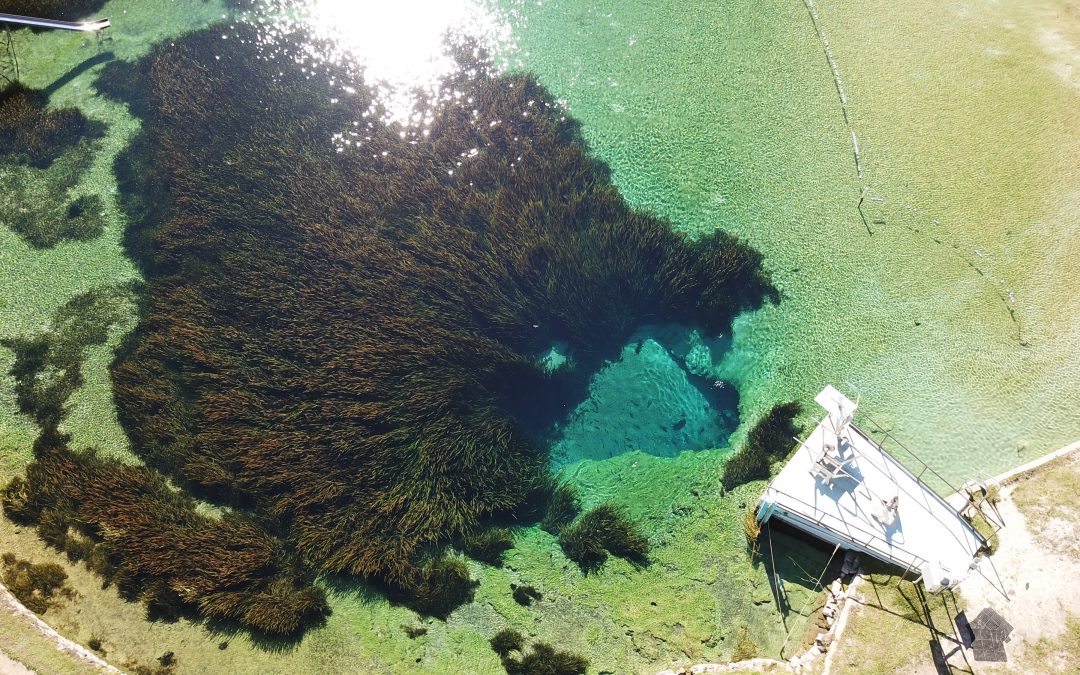
by Andrea Albertin | Jan 20, 2022

Jackson Blue Springs discharging from the Floridan Aquifer. Jackson County, FL. Image: Doug Mayo, UF/IFAS Extension.
Florida has one of the largest concentrations of freshwater springs in the world. More than 1000 have been identified statewide, and here in the Florida Panhandle, more than 250 have been found. Not only are they an important source of potable water, springs have enormous recreational and cultural value in our state. There is nothing like taking a cool swim in the crystal-clear waters of these unique, beautiful systems.
How do springs form?
We have so many springs in Florida because of the state’s geology. Florida is underlain by thick layers of limestone (calcium carbonate) and dolomite (calcium magnesium carbonate) that are easily dissolved by rainwater that percolates into the ground. Rainwater is naturally slightly acidic (with a pH of about 5 to 5.6), and as it moves through the limestone and dolomite, it dissolves the rock and forms fissures, conduits, and caves that can store water. In areas where the limestone is close to the surface, sinkholes and springs are common. Springs form when groundwater that is under pressure flows out through natural openings in the ground. Most of our springs are found in North and North-Central Florida, where the limestone and dolomite are found closest to the surface.
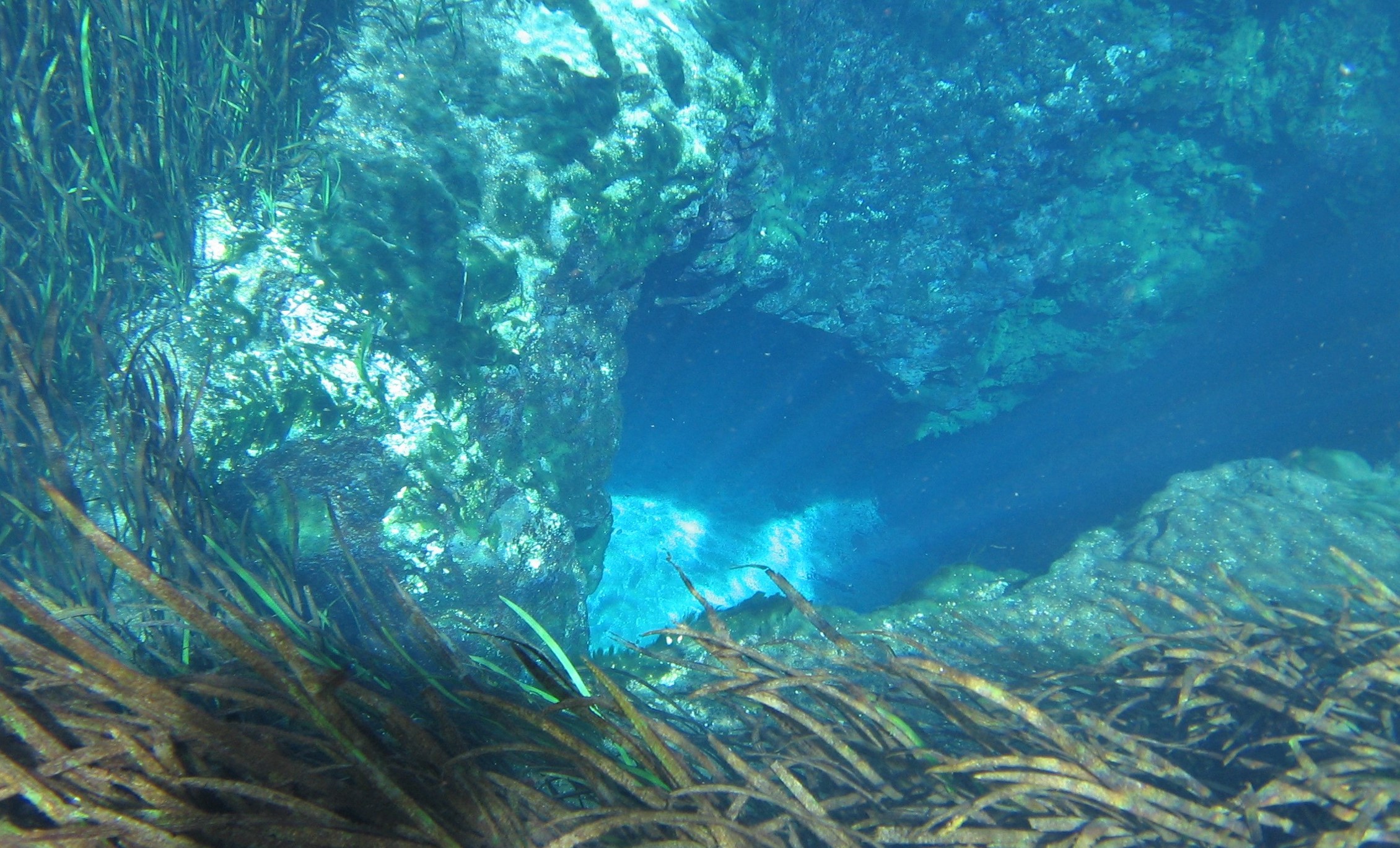
Springs are windows to the Floridan Aquifer, which supplies most of Florida’s drinking water. Image: Ichetucknee Blue Hole, A. Albertin.
These thick layers of limestone and dolomite that are below us, with pores, fissures, conduits, and caves that store water, make up the Floridan Aquifer. The Floridan Aquifer includes all of Florida and parts of Georgia, South Carolina, and Alabama. The thickness of the aquifer varies widely, ranging from 250 ft. thick in parts of Georgia, to about 3,000 ft. thick in South Florida. The Floridan is one of the most productive aquifer systems in the world. It provides drinking water to about 11 million Floridians and is recharged by rainfall.
How are springs classified?
Springs are commonly classified by their discharge or flow rate, which is measured in cubic feet or cubic meters per second. First magnitude springs have a flow rate of 100 cubic feet or more per second, 2nd magnitude springs have a rate of 10-100 ft.3/sec., 3rd magnitude flows are 1-10 ft.3/sec. and so on. We have 33 first magnitude springs in the state, and the majority of these are found in state parks. These springs pump out massive amounts of water. A flow rate of 100 ft.3/sec. translates to 65 million gallons per day. Larger springs in Florida supply the base flow for many streams and rivers.
What affects spring flow?
Multiple factors can affect the amount of water that flows from springs. These include the amount of rainfall, size of caverns and conduits that the water is flowing through, water pressure in the aquifer, and the size of the spring’s recharge basin. A recharge basin is the land area that contributes water to the spring – surface water and rainwater that falls on this area can seep into the ground and end up as part of the spring’s discharge. Drought and activities such as groundwater withdrawals through pumping can reduce flow from springs systems.
If you haven’t experienced the beauty of a Florida Spring, there is really nothing quite like it. Here in the panhandle, springs such as Wakulla, Jackson Blue, Pitt, Williford, Morrison, Ponce de Leon, Vortex, and Cypress Springs are some of the areas that offer wonderful recreational opportunities. The Florida Department of Environmental Protection has a ‘springs finder’ web page with an interactive map that can help you locate these and many other springs throughout the state.
https://nwdistrict.ifas.ufl.edu/nat/2020/04/09/the-incredible-floridan-aquifer/

by Laura Tiu | Dec 2, 2021
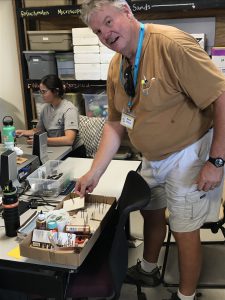
Florida Master Naturalist Student and Florida State Park Ranger, Bruce Williams, prepares for his snowy plover lesson.
There is an oft quoted proverb “those who can’t do, teach.” It is meant to be humorous, but it couldn’t be farther from the truth. Teachers of all kinds have enormous impacts on our lives. For graduates of the Florida Master Naturalist Program (FMNP) there is a line in the mission statement that reads “The FMNP teaches those who teach others about Florida’s unique ecosystems and wildlife.” In fact, to graduate, FMNP students must complete a project and present, or teach, it to the class.
A good teacher, like a good entertainer first must hold his audience’s attention, then he can teach his lesson (John Henrik Clarke). In a recent coastal class, we had the good fortune of having a State Park Ranger as a student. His job requires him to do interpretive education at the park, so he had quite a bit of experience under his belt. His project, a craft project involving the assembly of a cute snowy plover chick, was his way of holding his audience’s attention while he talked of the importance of preserving and protecting habitat for shorebirds.
I thought the project and message was impressive and worthy of sharing. To all of you teachers out there who work to make our lives and world better, thank you, and here is another great activity to add to your quiver. If you would like more information on the Florida Master Naturalist Program go here: https://masternaturalist.ifas.ufl.edu.
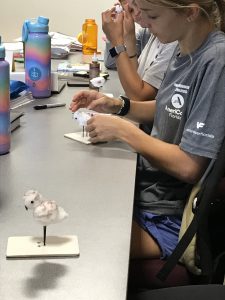
Making cotton ball snowy plover chicks
Group Project: Make a Snowy Plover Chick (Peipert, 2011)
This project is suitable for Elementary age through Middle school age children. It is recommended when doing project with a class or large group that some preparation is done ahead of time.
Supplies:
corrugated cardboard (disassembled brown packing box will do)
1 bag of cotton balls
1 container of black glass beads (sold at craft stores)
black sunflower seeds
1 container of wood toothpicks (kind with one end blunt)
1 can of black spray paint
several of each black, brown & gray markers
several bottles of quick dry tacky glue (sold at craft stores)
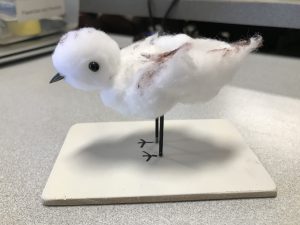
Cotton ball snowy plover chick craft
Preparation:
- Using an exacto or carpet knife and T-square cut corrugated cardboard into 3”x3” squares for the # of stands needed. To complete stand preparation, write Snowy Plover chick on stand, draw a pair of feet in center of stand and pierce cardboard in center of feet. This step is a real time saver and recommended for young children.
- Paint toothpicks with black spray paint for legs, easiest way to do this is by taking toothpicks and sticking them into a spare piece of cardboard upright them paint.
Instructions: (skip to instruction #3 if using stands with feet & holes premade)
- Draw a pair of bird feet on center of cardboard and if you want write” Snowy Plover chick” on cardboard.
- Use the pointed end of a toothpick to make a hole in the center of drawn feet. Then put the blunt end of toothpicks in the holes and put a heavy glob of glue around them. Don’t be shy with the glue, it will dry clear and will be better support.
- Take one of the cotton balls and roll around between hands to make it smaller. This will be the head. Next using all three or two markers make many dots on one side of both cotton balls creating a speckled pattern.
- Put a glob of glue at top of each toothpick and put larger cotton ball (the body) on top of toothpicks pushing down so the glue is covered by the cotton ball. Next put a glob of glue on the top of body and put white side of cotton ball (the head) on glue.
- To complete the chick put a small glob of glue on opposite sides of head then place glass beads on. Lastly put a glob of glue on side of head that the feet are facing forward and place sunflower seed on with the pointed end facing out.
- Let stand for at least 15 minutes to dry before handling.
- Enjoy your Snowy Plover chick creation!








